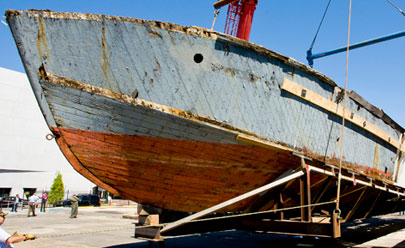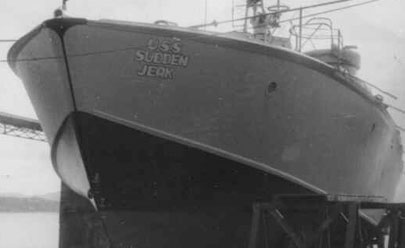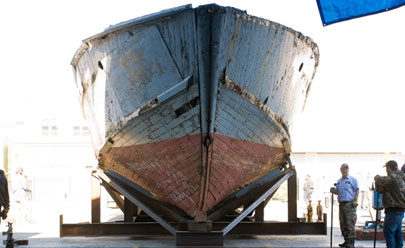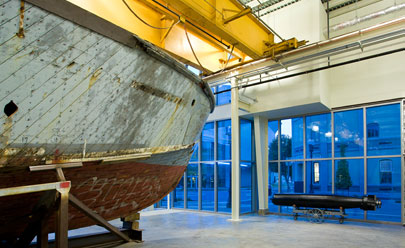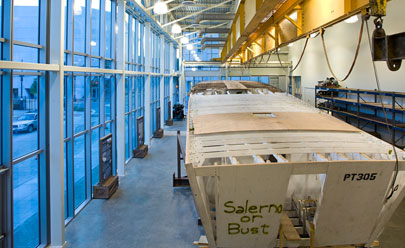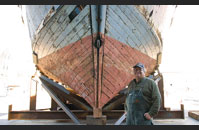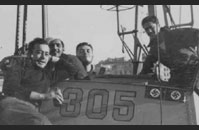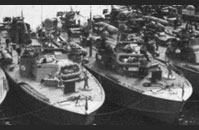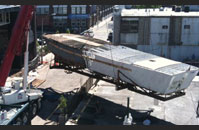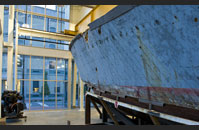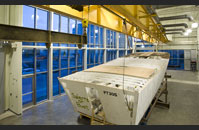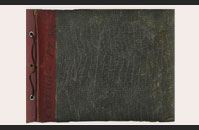FEATURED ARTIFACT: PT-305
The National WWII Museum is nearly finished with its multi-year project to restore a historic PT boat built by Higgins Industries in New Orleans, Louisiana. PT-305 served in the Mediterranean Theater of Operations and was known by several nicknames including The Sudden Jerk, The Bar Fly, and The Half Hitch.
PT-305, once housed in the Museum's John E. Kushner Restoration Pavilion, now resides in a custom-built boathouse on Lake Pontchartrain, where visitors can tour the boat or even book rides. Visit pt305.org for more info!
Keep up to date with PT-305 Restoration Project Updates on our blog!
Catch up on the work being done on the PT-305 in the John E. Kushner Restoration Pavilion with this exclusive video:
The History of PT-305:
PT-305 was manufactured by Higgins Industries in New Orleans. The keel was laid down on March 30, 1943 at the City Park Plant. She was launched on May 27, 1943 and completed at the Industrial Canal Plant on December 8, 1943.
For the American Navy the PT boat was a critical asset in the days after Pearl Harbor when the United States was short on larger vessels and facing an onslaught of attacks from the Japanese. The actions of PT boat crews in the Philippines and Solomon Islands represent an outstanding example of the American Spirit in action.
As the war progressed and America was able to mobilize more forces, the role of the PT boat shifted from attacks on capital ships to operations in coastal waters. PT boats slugged it out toe to toe with Japanese armored landing barges and German Flak lighters. Flak lighters or F-lighters were heavily armed and armored barges used by the German military to move men and material in coastal areas.
PT-305, along with PT-302 through PT-313, was assigned to Motor Torpedo Boat Squadron 22 (Ron 22). Ron 22 was commissioned on November 10, 1943 under the command of LCDR Richard J. Dressling and was assigned to the Mediterranean.
MTB RON 22 operated in the Mediterranean along the coast of Southern France and Northern Italy. Boats from Ron 22 participated in the Invasion of Elba on June 18, 1944, where PT-305 sank a German Flak lighter.
The squadron acted as a diversionary force in Gulf Juan, and as an anti-E-boat screen in the Nice-Cannes area. Ron 22 was part of Operation Dragoon, the invasion of Southern France on August 15, 1944. They landed French Commandos on the coast of France in preparation for the invasion. The squadron was also involved in action around Leghorn, Italy. To harass the enemy Ron 22 fired torpedoes into harbors between Genoa, Italy and the French-Italian border. On the night of April 24, 1945, PT-305 sank an Italian MAS boat.
In late April 1945, the squadron was returned to the United States to be overhauled in preparation for deployment to the Pacific. The war however ended while the squadron was still in New York Harbor. The Squadron was decommissioned November 15, 1945 still under the command of LCDR Richard J. Dressling. On June 18, 1948, PT-305 was sold along with the rest of the squadron.
PT-305 was modified for work as an oyster boat in the Chesapeake Bay. To save on fuel the three Packard engines which required 100 octane aviation gasoline to operate were removed and replaced with two diesel engines. All of the upper works were removed and a chart house was fitted at the stern. To avoid Coast Guard regulations requiring a licensed Captain of vessels over 65 feet in length, 13 feet of boat was removed from the stern.
PT-305 continued as an oyster boat for many years until 2001, when it was acquired by the Defenders of America Naval Museum in Galveston, Texas. In June 2006, The National WWII Museum was contacted by the Defenders of America Naval Museum about the possible transfer of PT-305. The vessel was transported to the Museum campus in April 2007. With the help of the faithful Higgins boat volunteers, PT-305 has been completely restored to her wartime condition. Everything except the weapons is fully operational. Its home is now a custom-built boathouse on Lake Pontchartrain, where guests will be able to purchase tours and rides on the boat. See pt305.org for more information.
Additional Images:
SUPPORTERS OF PT-305:
We would like to thank our supporters for their generous contributions.
Aluma Marine
APC Construction, LLC
Casadaban Marine Services, Inc.
PT-305 SCRAPBOOK:
Scrapbooks serve as self-curated exhibits, possessing the unique power to bring personal experiences to life straight from the page. In the spring of 2010, Kathy Kaminski donated to the Museum the scrapbook kept by her father, Edric Costain in 1944 – 45. The story of PT-305’s crew is narrated by Motor Machinist’s Mate 2nd Class Costain, who began his service onboard PT-305 in July 1944, months after the 305 reached her base at Bastia, Corsica.
Costain’s album shows us a world beyond the official histories and combat logs. We see young men posing for each other, full of both silliness and bravado. There are many snapshots of the crew posing at their posts — manning a 40mm gun or one of the four .50 caliber machine guns aboard the vessel. Other photographs show the crew in their leisure time, playing cards or touring Mediterranean locales like Corsica and Elba.
Not only does the scrapbook shed light on the daylight activities of the night-operating crew, but among its pages we find images of the various appearances of PT-305 during the course of the war. A photograph of the PT base at Bastia shows the boats with decks full of cots, sun tarps and a tangle of clotheslines, reminiscent of a crowded tenement neighborhood. Images of PT-305 underway show wide swaths of white water left in her wake. The photographs answer important questions for researchers and the Museum’s restoration crew about the many various paint schemes, armament and configurations adapted by PT boats in World War II. PT-305 is the pinup, the centerfold of this important album.
Flip through the PT-305 scrapbook:
Gift in Memory of Edric G. Costain, The National WWII Museum Inc., 2010.152

